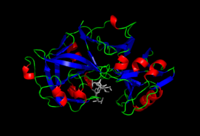
Photo from wikipedia
Protein-based targeting reagents, such as antibodies and non-antibody scaffold proteins, are rapidly inactivated in the upper gastrointestinal (GI) tract. Hydrochloric acid in gastric juice denatures proteins and activates pepsin, concentrations… Click to show full abstract
Protein-based targeting reagents, such as antibodies and non-antibody scaffold proteins, are rapidly inactivated in the upper gastrointestinal (GI) tract. Hydrochloric acid in gastric juice denatures proteins and activates pepsin, concentrations of which reach 1 mg/mL in the mammalian stomach. Two stable scaffold proteins (nanobody and nanofitin), previously developed to be protease-resistant, were completely digested in less than 10 min at 100-fold lower concentration of pepsin than found in the stomach. Here we present gastrobodies, a protein scaffold derived from Kunitz soybean trypsin inhibitor (SBTI). SBTI is highly resistant to the challenges of the upper GI tract, including digestive proteases, pH 2 and bile acids. Computational prediction of SBTI’s evolvability identified two nearby loops for randomization, to create a potential recognition surface which was experimentally validated by alanine scanning. We established display of SBTI on full-length pIII of M13 phage. Phage selection of gastrobody libraries against the glucosyltransferase domain of Clostridium difficile toxin B (GTD) identified hits with nanomolar affinity and enzyme inhibitory activity. Anti-GTD binders retained high stability to acid, digestive proteases and heat. Gastrobodies show resilience to exceptionally harsh conditions, which should provide a foundation for targeting and modulating function within the GI tract. Wicke, Bedford & Howarth present a protein engineering strategy focusing on the survival of protein targeting reagents in the GI tract. For this, they engineer a Kunitz soybean trypsin inhibitor as the scaffold and showcase the binding of the engineered antibody mimetics to Clostridium difficile toxins and the resistance of the binders to acid, digestive proteases and heat.
Journal Title: Communications Biology
Year Published: 2021
Link to full text (if available)
Share on Social Media: Sign Up to like & get
recommendations!